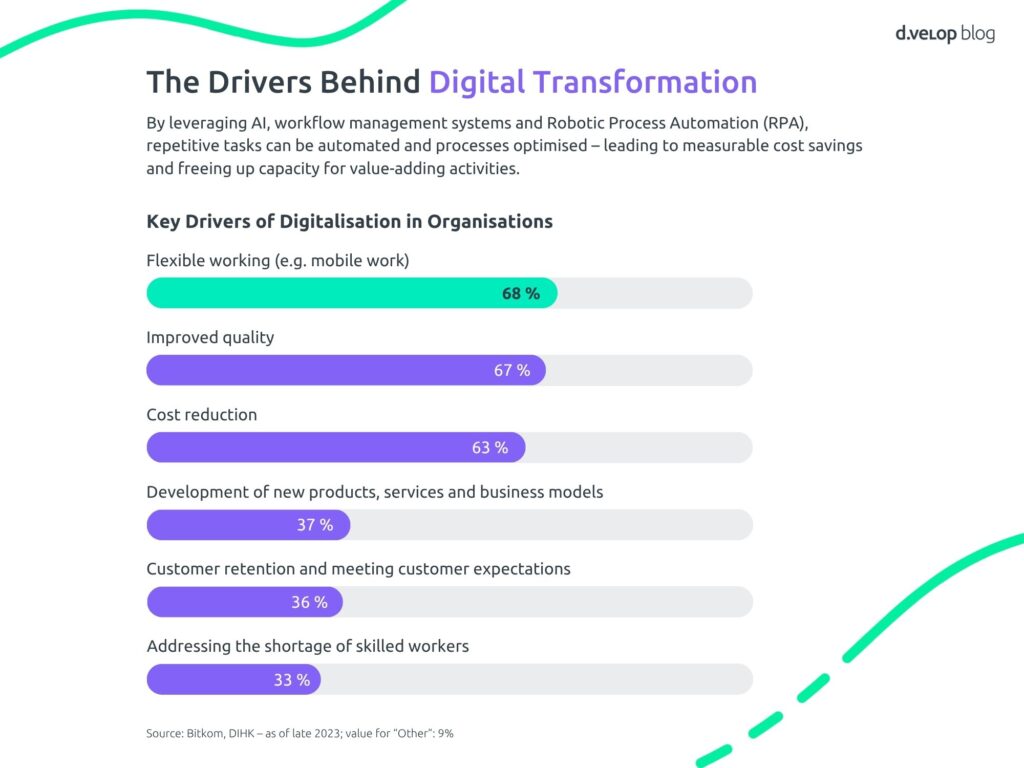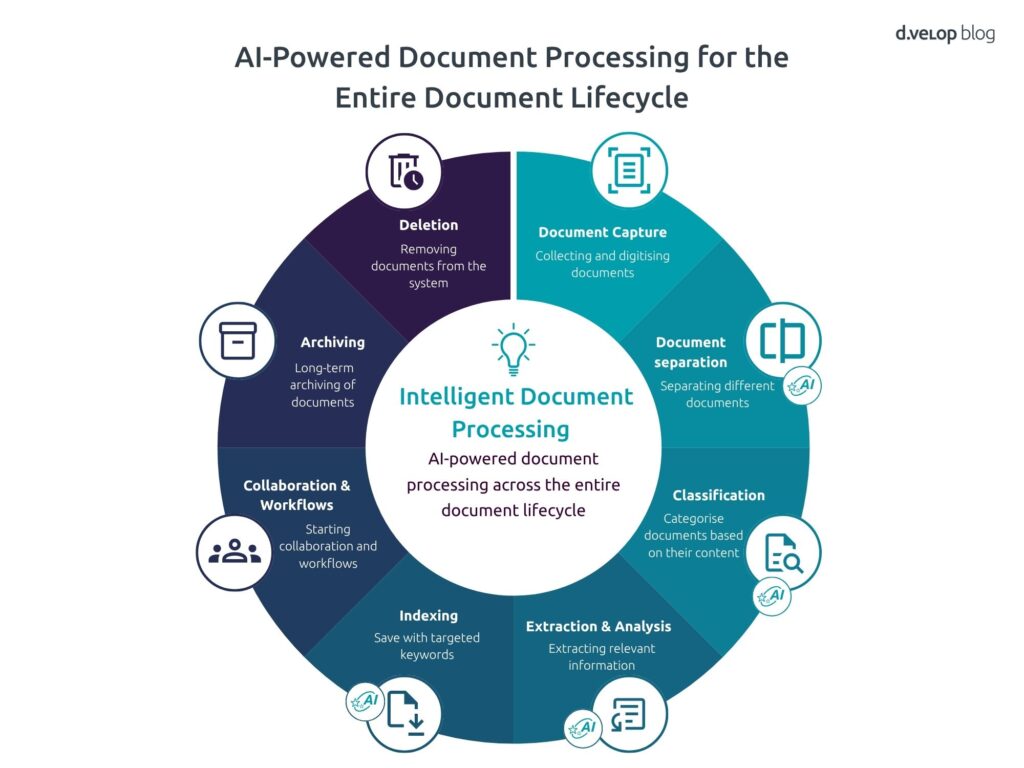Every day, countless invoices, forms, and receipts arrive in company inboxes — and all too often, the next step is manual data entry. Searching, sorting, typing: traditional processes like these are time-consuming, labour-intensive, and prone to error.
This is where Intelligent Document Processing (IDP) comes in. It combines AI-powered document analysis, automated document workflows, and intelligent text recognition. Modern AI solutions can identify content, automatically classify documents, and seamlessly integrate them into existing digital processes.
Turning Paper Mountains into Streamlined Digital Workflows
According to the “Document Trends 2024” study by Quocirca — a leading market research firm focused on IT and digital transformation — 63% of surveyed companies plan to increase their investments in intelligent document processing within the next year. In this article, you’ll learn how your organisation can turn an analogue paper mountain into an efficient, fully digital process.
Core Technologies Behind Intelligent Document Processing
Intelligent document processing goes far beyond simple scanning. It uses advanced technologies to automatically capture, analyse, and process invoices, receipts, or forms. Three key technologies form the foundation of modern AI document solutions — turning paper into structured, digital resources and enabling efficient workflows, automation, and true document intelligence:
1. Artificial Intelligence & Machine Learning
Whether it’s an invoice, contract, or form, AI-driven systems automatically detect patterns, structures, and content in documents. Through continuous machine learning, the software improves document classification and optimises automation over time — especially valuable when dealing with unstructured data.
2. Natural Language Processing (NLP)
Natural Language Processing enables machines to understand text. This is crucial for extractive document processing and NLP-based document analysis. The system can identify whether a file is an invoice, quotation, or contract and extract the right information automatically.
3. Optical Character Recognition (OCR) & Data Extraction
OCR transforms scanned documents into digital, searchable data. When combined with AI, it becomes a powerful text recognition tool that automatically reads invoices, sorts documents, and assigns them to the correct digital workflow. This makes OCR the foundation for a digital mailroom solution — something many organisations rely on today.
Tip: Using a modern document scanning solution lays the groundwork for efficient digital document management, saves time, reduces manual errors, and brings your organisation closer to a paperless, end-to-end digital workflow.
AI-Powered Document Processing Throughout the Entire Document Lifecycle
Organisations handle and evaluate vast amounts of documents and information daily. Intelligent document processing fundamentally changes how this is done. With AI-based recognition, automatic classification, and NLP, it enables documents to be captured, analysed, and converted into structured data — seamlessly and without media disruption. Typical Use Cases and Industry Examples
- Accounting and invoice processing: Incoming invoices can be automatically captured, validated, and forwarded to the booking workflow. AI extracts key data — such as total amount, due date, or supplier information — even from varied layouts. The result: automated workflows and minimal manual effort.
- Mailroom management and digital archiving: Incoming emails, letters, or faxes are digitally captured and stored in full compliance with GDPR. Thanks to AI-based classification, documents are automatically assigned to the correct process or person — keeping your digital inbox organised and efficient.
- Contracts and compliance documents: For sensitive documents such as contracts, privacy agreements, or audit reports, digital document processing offers clear advantages. Content is automatically detected, key passages are extracted, and — if required — analysed through NLP. This is a true efficiency gain in compliance-driven areas.
Industry Examples: Where Intelligent Document Processing Delivers Real Value
- Manufacturing: Automated processing of delivery notes, purchase orders, and production records
- Finance: Capture and validation of financial documents, account statements, and contracts
- Public Sector: Digital application processing, file management, and internal workflows
With intelligent document processing, paper-heavy operations are transformed into pure efficiency — using technology that not only scans but understands documents. It’s the next step from automatic data capture to truly end-to-end digital processes.
The Benefits of Intelligent Document Processing
Companies benefit most in terms of efficiency, data quality, and scalability. Automatically capturing, classifying, and processing documents means faster, more reliable, and fully digital workflows — saving time and operational costs. Employees are freed from repetitive, manual tasks and can focus on value-adding activities instead.
High Scalability and Flexibility: Competitive Advantages at a Glance
Unlike manual entry, automated document processing significantly reduces transfer errors. Data quality improves, and with it, the reliability of downstream processes — creating greater security and transparency across accounting, controlling, and contract management. Thanks to its scalability and flexibility, intelligent document processing adapts to individual business needs — whether you’re a small enterprise or a large corporation. As document volumes grow, this technology ensures your processes remain efficient, future-proof, and ready to scale.

Integration into Existing IT Infrastructures
Implementing Intelligent Document Processing (IDP) only creates real value when the software integrates seamlessly with your existing systems. Modern solutions make this possible through flexible interfaces, secure architectures, and full control over sensitive data.
Interfaces That Connect
Whether ERP, ECM or DMS systems – a powerful AI-driven document solution integrates effortlessly with existing applications. This allows the entire document workflow to be supported by AI, from document capture and automatic data extraction through to archiving and further processing within your systems.
Cloud or On-Premises: You Decide
Whether as a cloud service or an on-premises solution, intelligent document processing providers offer flexible deployment models that fit each organisation’s IT strategy and compliance requirements. Particularly in highly regulated industries, this freedom of choice is a clear advantage.
Data Protection Meets Automation
When automating document processes, security and GDPR compliance are key priorities. Access controls, encryption, and logging ensure that automated workflows — such as invoice capture — remain both efficient and legally compliant.
Interview: “Automation Starts with the Document”
How can organisations process documents more efficiently and establish digital workflows? The answer lies in intelligent document processing, especially when it leverages modern AI models.
We spoke with Malte Alsmeier, Product Owner at d.velop, about what makes d.velop’s IDP solutions stand out. In this interview, he explains how contextual understanding works independently of layout and language, which use cases benefit most, and what trends will shape the future of document processing.
Question: What makes d.velop’s Intelligent Document Processing unique?
Malte Alsmeier: The wide range of models within our d.velop IDP solutions enables us to extract information from virtually any type of document. The contextual understanding capabilities of our AI models deliver real added value — recognising content regardless of layout or language and even generating details that are not explicitly present in the document. This allows our customers and partners to establish end-to-end automation across all document intake processes. Additionally, some of our models require no traditional training, enabling us to deliver results much faster than conventional approaches.
Question: In which areas can AI deliver the greatest efficiency gains in document processing?
Malte Alsmeier: AI can add value across all scenarios involving non-standard document types — for example, in mailroom processing, where it’s unclear what kind of documents will arrive. It’s also highly effective in invoice processing. Even with the increasing introduction of electronic invoicing requirements, IDP continues to offer benefits, such as automatically interpreting early payment discount (Skonto) information.
Question: How does d.velop support organisations in implementing and using intelligent document processing in practice?
Malte Alsmeier: We advise customers on which AI model best fits their specific use case and often validate this through small proof-of-concept projects (POCs). We’ve already received very positive feedback from customers currently running IDP pilot projects.
Question: What trends and developments do you foresee in the coming years in the field of intelligent document processing?
Malte Alsmeier: Already today, with d.velop pilot, we are able to aggregate and interpret large document volumes and answer questions directly within the document context. This capability will become increasingly important in everyday work. In addition, large language models (LLMs) are becoming more powerful and cost-efficient to operate. We expect to see continued optimisation in the coming months, making them the next-generation recognition technology for document intake — even as a standard feature.

Conclusion: d.velop – Your Trusted Partner for Intelligent Document Processing
When organisations set out to digitise and automate their business processes, success requires more than just a good idea — it requires a partner who combines expertise, experience, and innovation. That partner is d.velop. With intelligent workflow software, powerful process management tools, and a strong focus on AI-driven process automation, d.velop provides everything modern organisations need for future-ready Intelligent Document Processing (IDP).

Smart Technology and Comprehensive Workflow Management
From the initial analysis and tailored consultation to the delivery of a customised solution, d.velop supports its customers every step of the way towards a truly digital workplace – efficient, reliable, and practical. Thanks to continuous innovation and dedicated personal support, your solution remains powerful and future-proof. Choosing d.velop means investing not only in smart technology, but in comprehensive workflow management that truly understands and shapes digital processes.
Ready to streamline your document workflows?
Intelligent Document Processing from d.velop uses AI to automatically capture, classify and process documents – reducing manual effort and enabling seamless digital workflows.
FAQ
Intelligent Document Processing (IDP) uses technologies such as Artificial Intelligence (AI), Machine Learning and Natural Language Processing (NLP) to automatically scan, read, identify and process documents. It enables automated data capture, classification and extraction from invoices, forms or receipts – without any manual input. This creates seamless, digital workflows that accelerate processes, reduce errors and support organisations in automating their document management.
OCR (Optical Character Recognition) simply converts the text from scanned documents into machine-readable characters. IDP goes much further: it uses AI to understand content, classify documents, extract relevant data and trigger workflows – for example, automatically reading invoices, identifying form fields or sorting documents. IDP is therefore a comprehensive solution for automated, digital document processing in modern organisations.
Intelligent Document Processing is applied when documents such as invoices, forms or receipts need to be automatically identified, classified and processed. Using AI, NLP and advanced text recognition, content is read, relevant data is extracted and transferred into digital workflows. This allows documents to be automatically sorted, stored and integrated into existing systems such as document management or digital mailroom solutions – efficiently, securely and without media disruption.
